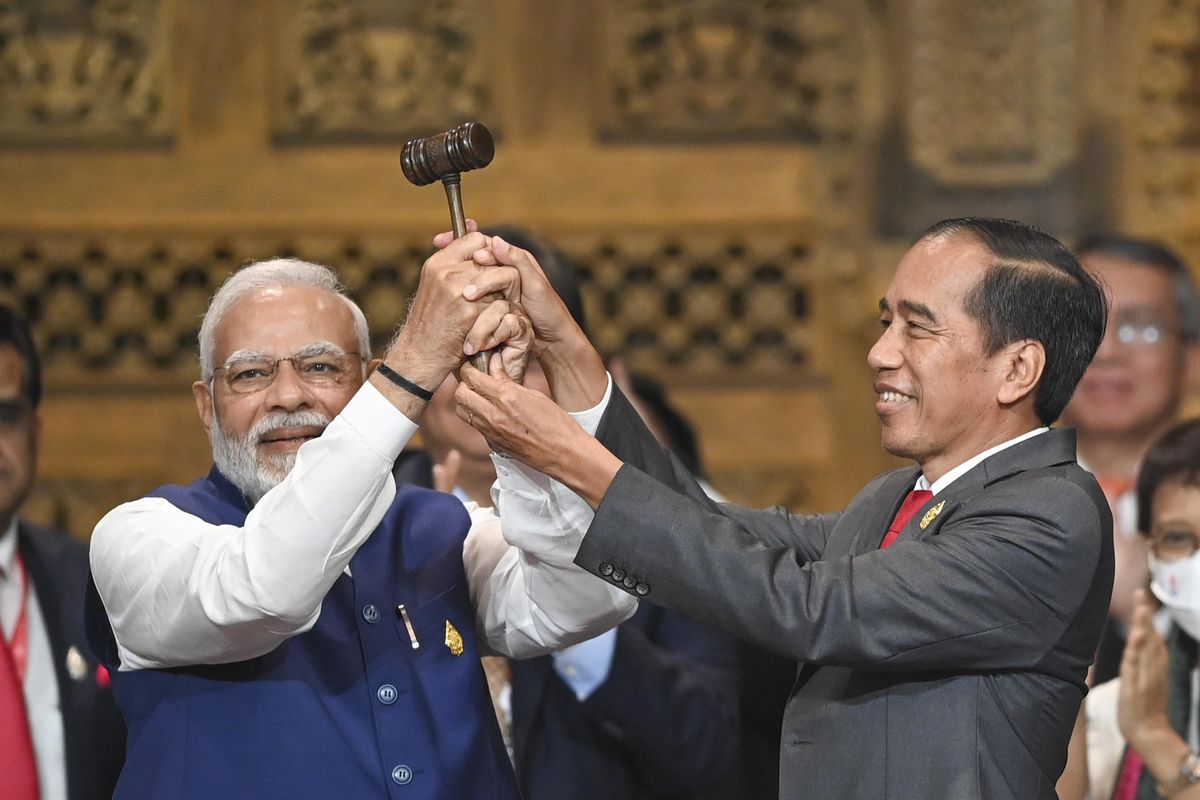
Indonesian President Joko Widodo (R) hands over the G-20 presidency gavel to India’s PM Narendra Modi (L) at the G-20 summit in Bali.
On Dec. 1, India will assume the year-long rotating presidency of the G-20, a grouping that brings together representatives of the world’s largest economies to coordinate responses to the leading problems of the day. Prime Minister Narendra Modi wants to make the Indian presidency one to remember. In fact, he asked Indonesia to take India’s place in the scheduled G-20 rotation last year because he felt the country was behind on preparations that include rebuilding a portion of New Delhi, India’s capital city.
We asked Eurasia Group expert Pramit Pal Chaudhuri to explain why Modi is making such a big bet on the G-20 presidency and how he hopes to address some of the world’s challenges.
Is Modi expecting some sort of political gain?
India will be gearing up next year for national elections in early 2024. So, when Modi unveiled a logo for the G-20 presidency that included the lotus flower — which is both India’s national flower and the symbol of the ruling BJP party — the opposition immediately accused him of exploiting the occasion for electoral purposes.
Modi is likely betting that the international attention generated by the G-20 meetings will elevate the profile of the BJP in the eyes of voters. Events will be held throughout the country, including in Kashmir, which is claimed by neighboring Pakistan. (China, an ally of Pakistan, has already refused to participate in those events.)
But beyond the short-term electoral considerations, Modi is thinking about his legacy. The 72-year-old leader is hoping to advance global solutions to problems such as climate change during his time at the helm of the G-20.
But the G-20 is very divided. How will Modi manage the geopolitical tensions?
Yes, it’s true that Russia’s invasion of Ukraine and the intensifying rivalry between the US and China have created divisions. And India has problems of its own with China — relations have been in a deep freeze since a Himalayan border clash in 2020. But Modi has been working to unfreeze them.
After two years of zero contact, Modi shared a podium with Chinese President Xi Jinping at the Shanghai Cooperation Organization summit in September and followed it up with a handshake and a brief chat at the G-20 leaders’ summit earlier this month in Indonesia. That will likely pave the way for Xi to come to the same event next September in New Delhi.
Meanwhile, India has been working to bridge the divide over Ukraine. Many countries in the developing world – including India and China – have either opposed or been reluctant to go along with the West’s campaign to punish Russia for its actions. At the G-20 summit earlier this month, Indian diplomats worked overtime to get all sides to agree to language in the summit communique that condemned the war but recognized differing views among members.
What will be the main focus of India’s G-20 presidency?
Amitabh Kant, India’s G-20 sherpa (lead negotiator), recently said that trying to reinvigorate the world economy will be at the top of the agenda: “By the time we take over … many parts of the world will go into recession… almost 70 countries will be impacted by global debt.” India has already got traction on a proposal for developed country central banks to offer currency swaps to countries in the Global South to help them secure the supplies of foreign currencies they need to pay off debt and pay for imports.
Modi himself, however, has suggested that much of the agenda will focus on climate issues. For example, Indian officials want to discuss ways to direct global capital to emerging-market countries to help them fund transitions to less-polluting forms of energy. One idea, they say, is to get multilateral financial institutions such as the World Bank to become more proactive in financing projects in this space. Another is to create a new multilateral program to underwrite private investment in green energy projects.
Are there other items of note on the agenda?
The Modi government is trying to get the G-20 members to consider a coordinated global regulatory response to cryptocurrency, given the ease with which it crosses borders and transactions are shifted to offshore sites. It will also press the demands of emerging market countries for a greater share of the votes at institutions such as the World Bank and the IMF. Indian officials say they don’t want to clutter the agenda with too many items, preferring to keep the focus mostly on growth and climate.
